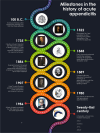Acute appendicitis and its treatment: a historical overview
- PMID: 39881071
- PMCID: PMC11779765
- DOI: 10.1007/s00384-024-04793-7
Acute appendicitis and its treatment: a historical overview
Abstract
Purpose: Acute appendicitis (AA) is the leading cause of acute abdomen worldwide, with an incidence of 90-100 cases per 100,000 individuals annually and a lifetime risk of 7-12%. Despite its prevalence, historical accounts of AA are limited, particularly when compared to conditions like haemorrhoids, likely due to the appendix's internal location. This article traces the historical evolution of AA treatment from ancient times to the present, highlighting key contributions.
Methods: A review of common research databases and relevant literature on AA was conducted.
Results: Evidence from ancient Egypt suggests early recognition of the appendix, referring to it as the "worm of the bowel." However, detailed anatomical descriptions and treatment approaches for AA did not emerge until the Renaissance, particularly with contributions from Leonardo da Vinci and Berengario da Carpi. The article traces the progression of AA management, including the first autopsies and surgeries, the development of surgical techniques predating anaesthesia and antisepsis, and advancements achieved from the nineteenth to the twenty-first century. The shift from conservative to surgical approaches is discussed, alongside innovations such as laparoscopic appendicectomy, single-incision laparoscopic surgery (SILS), natural orifice transluminal endoscopic surgery (NOTES), and endoscopic retrograde appendicitis therapy (ERAT). The impact of the COVID-19 pandemic on AA treatment, including adaptations in medical practices, is also explored.
Conclusions: This review highlights the significant historical developments in AA treatment and its pivotal role in advancing abdominal surgery.
Keywords: Acute appendicitis; Appendectomy; Appendicectomy; ERAT; Historical overview; History; History of medicine; Laparoscopic; Laparoscopy.
© 2025. The Author(s).
Conflict of interest statement
Declarations. Conflict of interest: GP and FP are editors on this journal, but are recused from the Editorial peer review process of this article. None of the other authors has a conflict of interest to declare. Ethics approval and consent to participate: Not applicable. Disclaimer: The images from 1 to 17 that accompany the article are more than 75 years old and hence out with copyright rules. All sources have been attributed.
Figures






















References
-
- Di Saverio S, Podda M, De Simone B, Ceresoli M, Augustin G, Gori A, Boermeester M, Sartelli M, Coccolini F, Tarasconi A, De’ Angelis N, Weber DG, Tolonen M, Birindelli A, Biffl W, Moore EE, Kelly M, Soreide K, Kashuk J, Ten Broek R, Gomes CA, Sugrue M, Davies RJ, Damaskos D, Leppäniemi A, Kirkpatrick A, Peitzman AB, Fraga GP, Maier RV, Coimbra R, Chiarugi M, Sganga G, Pisanu A, De’ Angelis GL, Tan E, Van Goor H, Pata F, Di Carlo I, Chiara O, Litvin A, Campanile FC, Sakakushev B, Tomadze G, Demetrashvili Z, Latifi R, Abu-Zidan F, Romeo O, Segovia-Lohse H, Baiocchi G, Costa D, Rizoli S, Balogh ZJ, Bendinelli C, Scalea T, Ivatury R, Velmahos G, Andersson R, Kluger Y, Ansaloni L, Catena F (2020) Diagnosis and treatment of acute appendicitis: 2020 update of the WSES Jerusalem guidelines. World J Emerg Surg 15(1):27. 10.1186/s13017-020-00306-3 - PMC - PubMed
-
- Bhangu A, Søreide K, Di Saverio S, Assarsson JH, Drake FT (2015) Acute appendicitis: modern understanding of pathogenesis, diagnosis, and management. Lancet 386(10000):1278–1287. 10.1016/S0140-6736(15)00275-5.Erratum.In:Lancet.2017Oct14;390(10104):1736 - PubMed
Publication types
MeSH terms
LinkOut - more resources
Full Text Sources
Medical

